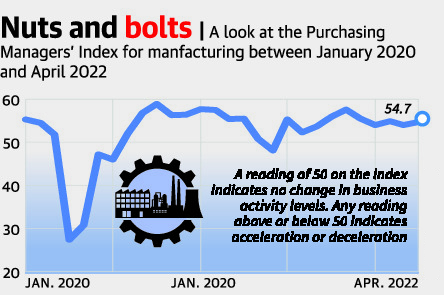Context:
According to the S&P Global India Manufacturing Purchasing Managers’ Index (PMI), new orders and output in India’s manufacturing sector increased slightly in April 2022, rising to 54.7 from 54 in March 2022.

Relevance:
GS-III: Indian Economy (Growth and Development of Indian Economy, Mobilization of Resources)
Dimensions of the Article:
- What is Purchasing Managers’ Index (PMI)?
- Understanding PMI
Key Highlights of the Index
- New export orders rebounded in April after contracting for the first time in nine months in March.
- In economics, contraction refers to a period in the business cycle when the economy is contracting.
- Inflationary pressures grew, owing to increased commodity prices, the Russia-Ukraine war, and higher transportation costs, as the business cycle peaks but before it troughs.
- Input costs rose at their quickest rate in five months, while output charge inflation soared to a 12-month high. Energy price volatility, global input shortages, and the conflict in Ukraine all contributed to an increase in inflationary pressures, according to the latest statistics.
- In April 2022, there was just a minor growth in employment.
What is Purchasing Managers’ Index (PMI)?
- The Purchasing Managers’ Index (PMI) is an index of the prevailing direction of economic trends in the manufacturing and service sectors.
- It consists of a diffusion index that summarizes whether market conditions, as viewed by purchasing managers, are expanding, staying the same, or contracting.
- The purpose of the PMI is to provide information about current and future business conditions to company decision makers, analysts, and investors.
- In simple words, Purchasing Managers Index (PMI) is a measure of the prevailing direction of economic trends in manufacturing.
- PMI is a survey-based measure that asks the respondents about changes in their perception about key business variables as compared with the previous month.
- The purpose of the PMI is to provide information about current and future business conditions to company decision makers, analysts, and investors.
- It is calculated separately for the manufacturing and services sectors and then a composite index is also constructed.
- PMI is compiled by IHS Markit for more than 40 economies worldwide – IHS Markit is a global leader in information, analytics and solutions for the major industries and markets that drive economies worldwide.
Understanding PMI
- The PMI is a number from 0 to 100.
- A print above 50 means expansion, while a score below that denotes contraction.
- A reading at 50 indicates no change.
- If PMI of the previous month is higher than the PMI of the current month, it represents that the economy is contracting.
- It is usually released at the start of every month. It is, therefore, considered a good leading indicator of economic activity.
- It is different from the Index of Industrial Production (IIP), which also gauges the level of activity in the economy.
- IIP covers the broader industrial sector compared to PMI.
- However, PMI is more dynamic compared to a standard industrial production index.
-Source: Indian Express




